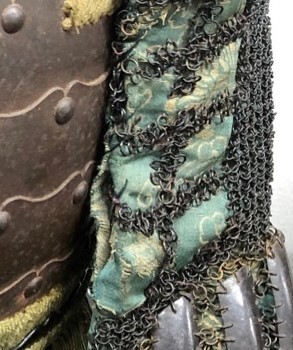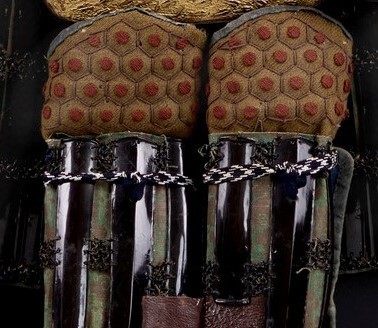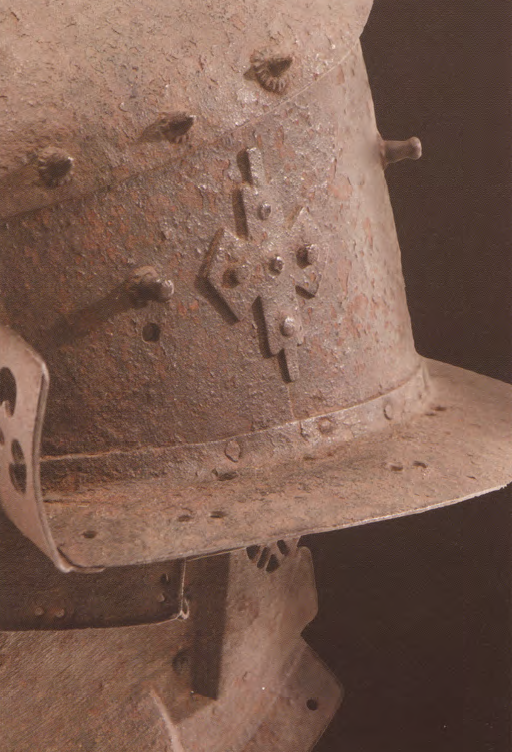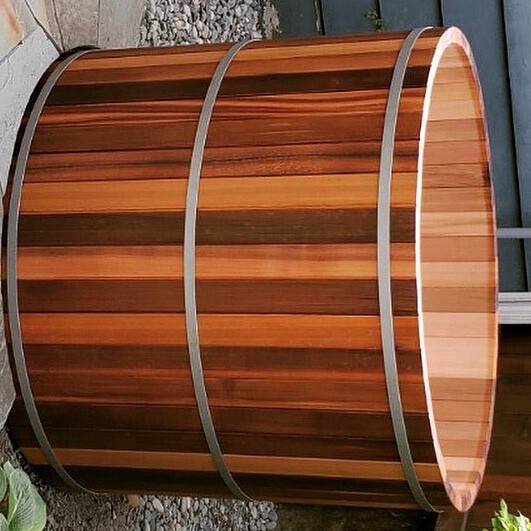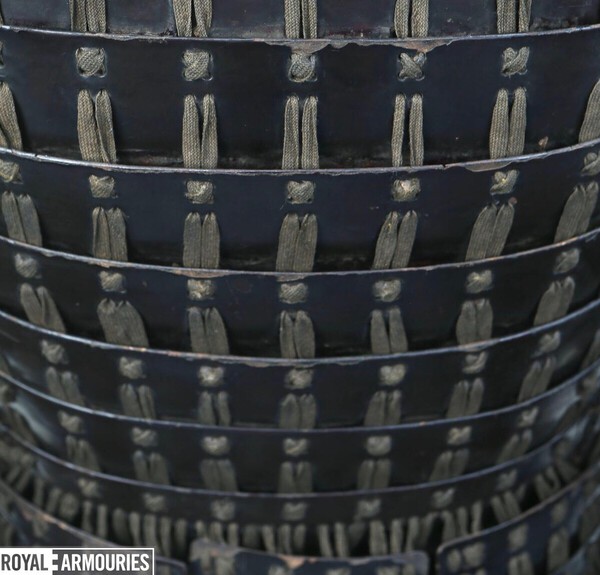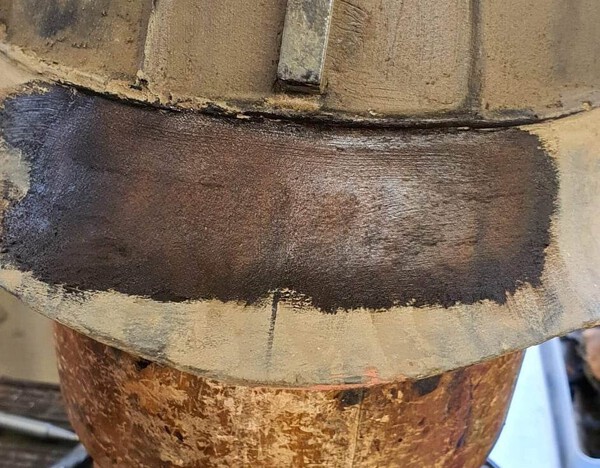-
Posts
127 -
Joined
-
Last visited
-
Days Won
1
Content Type
Profiles
Forums
Events
Store
Downloads
Gallery
Everything posted by chris covington
-
We’ve all seen swords polished by “those guys.” They have some basic skill, and clean the blade up, but up-close you see they destroyed the proper geometry of the sword, for the era and school. I never realized that the armor community is filled with those amateur folks, hocking their services as professionals, too. Just as it is important for a polisher to understand all of those important details about sword schools, eras, smiths, etc. a katchushi needs that same level of knowledge about schools of armor. I think we’re lucky to have Mr. Mancabelli here, since he has that level of study. If you want mochi go to a mochi maker, not a baker. If you want katchu work, go to a katchushi, not a bowl lacquerer. Chris Btw, Mr. Hennick, are we the only people who use our full names around here? I feel like I’m in a mid-90s AOL chatroom sometimes. 🤣
-
Mr. Mancabelli, I have often thought about this topic. It’s so hard for a skilled artisan to stay in business. The economic realities are tough. I remember several years ago studying an amazing Ko-Ichimonji tachi. The short time I had with it was great. This had everything you might want in a Nihonto. I started to think about the cost of shinsakuto. The cost to have a sword made by a top smith wasn’t that much different from this 13th century sword. That is a harsh reality. You know where most people would put their money. I love that guys like you, Mr. Kadoya, Mr. Nishioka, Arthur, and a handful of other real katchushi are still making this stuff, for real. I remember the video of you and your dragonfly maedate. Do you still have that, or at least photos of it? I’d love to see more of it and maybe a bit about. Amazing work. I’ve heard Arthur’s okitenugui called the best kabuto made outside of Japan. Mr. Kadoya’s social media pages are filled with an almost “how to” level of detail. Mr. Nishioka has made some great pieces, as well. We need more of this. The community should really be supporting artists who are making real armor, beyond just having them repair antiques. Once the handful of real artists are gone there won’t be anyone to relace and repair the antiques. What will fill that void will be pretty bad. Thanks, Chris
-
Mr. Andy Mancabelli is probably one of the most qualified individuals to repair a helmet. He goes by Miura here (his art name). Check with him and see what he says.
-
Wait, stamp that and reverse it. I shouldn’t reply at 5am before I’ve had coffee. That was my mistake. 🤣🤣🤣
-
I was going to ask, why is the front plate in the back and the Saotome rivet in the front?!? Maybe it was refitted and they fixed it backwards?
-

The Edo Chop Shop: Documenting Fakes Produced in Europe
chris covington replied to Arthur G's topic in Katchu
Mr. Thatcher, Welcome. First off, EVERYONE in the community knows who Date Masamune is at this point. So, you can please drop the charade. It’s like watching Ed Norton in his boss’ office in Fight Club. This is the ultimate in strawmen. The critique of the work, thus far, has been from transparent accounts. Why on earth would one of us use a fake account to make a new critique, on an armor not worth mentioning in this thread? It is an attempt to deflect the attention off of the topic, cry foul, and try to get the ref to throw a yellow card. I’m not interested in circular conversation over this like I’ve had with Mr. Noble, “Nuh uh, prove it.” Let's not insult each other's intelligence. If you’d like to refute any of the points I’ve brought up, please feel free to do so. Best regards, Chris -

The Edo Chop Shop: Documenting Fakes Produced in Europe
chris covington replied to Arthur G's topic in Katchu
Grey, You're just asking the same questions that I already addressed above. You seem to trust that those sangu weren't original and that the previous dealer had swapped them. I can ask you to prove the unprovable, too: "How do you know that they swapped them out? Can you prove it? How do you know?" This is a little silly. I'm not interested in having a conversation that goes into the schoolyard, let's deal with facts. We know what it looked like when it was first sold, and we know it was changed. Let's deal with those facts. What it had was period appropriate sangu for both the region and the era. The sangu matched the urushi on the rest of the armor from the photos. It was swapped for sangu that don't match as well. Why? Also, the kusari between the splints of the replaced kote is missing. It is just as damaged at the original set it came with, so even less reason to swap it. The maedate was period appropriate for the region and era, and was a "standard pattern" we've seen on multiple armors, from the same time period and region (There is a photo above). It was replaced with something much more exotic and fancy, why? These swaps were superfluous. "Original maedate crest with ponytail kashira date" if the Kaga beetle wasn't original, the hairy replacement certainly wasn't! It was an even later addition. Best regards, Chris -

The Edo Chop Shop: Documenting Fakes Produced in Europe
chris covington replied to Arthur G's topic in Katchu
I was using it a bit colloquially. -

The Edo Chop Shop: Documenting Fakes Produced in Europe
chris covington replied to Arthur G's topic in Katchu
Hi Grey, So, that really depends on the buyer, I guess, huh? What does the buyer think they are getting and what is the seller selling it as? If the buyer thinks they are getting a gusoku (for clarification I am using the term as a fully matched armor made to be fully matched, I realize that term has some ambiguity depending on the era and region) and it has parts swapped out, particularly parts used to enhance the salability, well, that’s a problem wouldn’t you agree? This armor is of rather late manufacture, I think we can agree on that; late-Edo? How many sets of sangu would it have had? I don’t know, but I would wager not many, if more than one. If it was a Muromachi armor, yeah, no doubt. You’re asking me to prove something that is impossible, though. I can ask the same question in reverse, but that isn’t fair either. The original owner could have switched out sangu 500 times, sure, but we need to deal with likelihood not possibility, and I don’t think it’s likely. What we know for sure is that it had an appropriate set before this superfluous swap, and these are facts we can realistically talk about. In my line of work the simplest answer is usually the right one. This Kaga armor had sangu that was completely appropriate for it’s original manufacture. It is fair to assume that set, that it had before, is likely the original one, even if it isn't, it is what came down to us through history. Next, we have to consider this item historically. Yes, in the Edo period and before they would mix and match pieces to keep it alive, but at some point (in the case of armor, more than a century and a half ago) it goes from being military kit to artifact of cultural value. They are no longer the same, nor should they be treated that way. While the samurai who owned it might not have walked around with a torn sangu, and he might have upgraded, there is a point where we need to treat this differently, and I think historically we are past that point. It is now appropriate to preserve these items, not keep them running as military kit incase the Mongolians invade again. Anything else should raise some serious red flags. Finally, let’s look at the old set of sangu and compare it a little to the new set. Look at the urushi finish. On the old set the urushi finish matches the finish of rest of the main body of the armor. The bottom most lame of the dou is urushi, as are all of the gesan and kanagu mawari. This has a nice matte finish. The new set has a much higher gloss. It is particularly notable on the suneate and haidate. A bit of polish could shine everything else up, or bring it down to a matte finish, but that’s not what we are seeing in the photos, these do not match. As for the maedate, well we know it didn’t come with the hairy kamon, because it was sold with the Kaga beetle horns. We also know from many extant examples that Kaga armor from this time period included the Kaga beetle horns as a standard maedate. Is it the original maedate that came with it when it first was made? Again, you are asking me to prove the impossible as above. If we ask questions like that, we can ask, is the helmet original to the armor? Are the sode original to the armor? Maybe the entire thing is composite from multiple armors, and it was relacquered in the Meiji era to look like a gusoku? How far can we or should we take it? I’m more willing to take the original sale and the original parts it came with in good faith, over this restoration (and when we condiser the title of this thread… well that makes me even less likely to trust it). When it is specifically advertised as “Original maedate crest with ponytail kashira date,” but we know that hairy maedate is not what was in the original sale, well, the whole thing is called into question, or at least it is in my mind. As for restoration, of course, we need to restore our antiques. Of course, swords are repolished (I have a few I need to send out). Of course, kodogu need to be repaired when dropped or mishandled. Of course, saya need to be replaced from decades of accumulated dirt. As I mentioned above, you don’t just swap out tsuba to get a little more for the sword, and say, “well, in the past samurai would swap tsuba based on their tastes…” That isn’t restoration, that is justification of bad actions. Restoration and parts swapping are not the same. They aren’t in the sword world, and they aren’t in any other field of serious antiques and collecting that I know of (at least not without disclosure, and they certainly wouldn't call a swapped part original if it wasn't). Not naïve, just calling it like it is. Best regards, Chris -

The Edo Chop Shop: Documenting Fakes Produced in Europe
chris covington replied to Arthur G's topic in Katchu
So, our club girls are getting ready for the disco. They have fake eyebrows, fake hair, and more make-up than anyone should ever have on. They get their dresses on and meet up. Each one is wearing a very different outfit. Suddenly they decide to mix and match like a toddler picking out their own outfit!?! What gives? Everything was matching and looking good, but for some reason they swapped articles of clothing and accessories and they’re not looking so great. Like everything with these girls, in the dim light, things look good; in bright light, maybe not so much. Many of us have seen this happen in the Nihonto world. A shady dealer has a nice sword with an otherwise plain tsuba on it (or more likely a nice iron tsuba, but something that isn’t flashy). He also has a lower quality sword that has a fancy *looking* tsuba on it (it might be low end when you inspect it, but again it *looks* fancy). What does he do? He swaps them! He’ll still get the same for that lower end sword as he would have gotten, but now that higher end sword looks even better with a fancy tsuba on it. He can charge even more for it now! A simple swap and money was made. Here’s the problem, both swords had authentic full koshirae. Now those koshirae are composite and broken up, for no reason other than a few extra dollars. A bit of cultural vandalism for a buck. Here we are presented with an original Kaga armor. It has matching sangu and a nifty Kaga maedate. This is an all-original matching armor. It might need a little cleaning up and care, but it is a pretty nice looking armor. 1. Original condition For some inexplicable reason, when it was cleaned and resold it suddenly got all new sangu and maedate. This went from an all-original matching armor to a composite armor. Let’s look it over. 2. cleaned and altered condition The original maedate had the Kaga symbol. On the red helmets a few posts above the same symbol can be found (I’ve heard this isn’t a kamon but more of a logo or symbol, so I won’t call it a kamon). This type of maedate was pretty common on Kaga made armors. Suddenly when it is for sale that original maedate is gone and another is in place (although the replacement was advertised as the original, “Original maedate crest with ponytail kashira date.“). This is a more complex maedate, and to some, more attractive. The fact the maedate was advertised as original, even though we can clearly see in the before photos it had a different crest should throw up some red flags. There is our first swap, for no reason. 3. Original maedate 4. another example of a Kaga armor with same maedate 5. replacement maedate Now check out the kote. The original fabric is a blue-green linen with some sparse white detail. This same fabric is on the haidate, as well (I assume the suneate, too, but can’t be sure based on the photos available). We can also see the shape of the splints on the forearm. Of particular interest, look at how the chains connect the splints, there are numerous holes that go up each splint with kusari between. When the armor is cleaned and offered for sale, we have all new sangu! The fabric is greener in color and appears to be silk with a lot more detail. The splints on the kote are flatter. You can also really see the holes between the splints, and there are only a few, with no kusari, very unlike the original kote. The haidate has the different green silk fabric as well. This is a whole new sangu set. This is not the original sangu to the armor, but a similar replacement. Why? Well, look at the chainmail on the left arm. There is some missing mail right at the inside of the elbow. Between the splints there is chain missing. There are some holes in the blue fabric at the armpits. This sangu needs work. Maybe it is beyond the craftsman’s ability? Or maybe it is quicker and easier to just swap them out. Why repair anything at all, when you can just swap? Also, the new sangu have silk instead of linen. Silk is nicer and fancier, if you have a silk backed sangu in better condition, well it becomes more appealing to the eye, right? So, another swap. 6. close up of original sangu fabric 7. close up of replacement fabric 8. original kote, note the damage to the chainmail and where the chainmail connects to the splints 9. replacement chainmail, also note the splints and the holes where the chain would attach 10. original haidate, the fabric is from the original sangu 11. replacement haidate and replacement fabric Now let’s check out those suneate. Are they the same? Well, the pre-cleaned photos only show so much. If I was a betting man, I’d say no though. Why? Look at the kiko at the knees. The original armor had dark blue fabric, purple thread, orange odoshi and light blue edging. Now take a good look at the suneate knees. Well, that doesn’t match! Brown fabric, red odoshi (unsure of the thread) and light blue edging. We can also see the suneate have fabric that matches the rest of the replacement sangu fabric. Another swap for no reason. 12. original suneate with kiko at the knees that matches the rest of the armor 13. replacement suneate with mismatched kiko So, what’s the big deal? New sangu, no biggie; except we had an all original armor, with original sangu, maedate, etc. that has been broken apart for absolutely no reason, other than quick "repair" and or sale. I am hopeful the new owner was given the old sangu and maedate, to keep the original set together. The armor went from a full original set to a composite armor for absolutely no good reason. Maybe the owner can ask to have to original sangu, if it hasn’t already been composited into another armor? I hope they paid composite armor prices and not full gusoku price. The steel did polish up nice, but otherwise it is a bit of cultural vandalism. People want to trust, it is in our nature. We want to believe in something or someone. Caveat emptor. Best regards, Chris -
Mr. Bottomley, Thank you for the detailed consideration. Arthur mentioned iyozane in the 1400s. Is this the same thing you are describing? I sometimes get all of the terms confused. Best regards, Chris
-
Mr. Taelman, I haven’t studied archaeology since undergrad, and it was only an intro class (we only briefly reviewed carbon dating), so forgive the questions. What part of the armor do they radio carbon date? I assume it would either be a bit of fabric or the urushi? If it is the urushi it should really help to nail stuff down (fabric could be reused from older projects, not the case with urushi). Like I said, I haven’t studied this stuff in a long time (1990s). How accurate is the process these days? I assume they’ve probably gotten better at it than they were 30 years ago. Do the labs still give confidence scores and date ranges. Sorry for the dumb questions. I’m trying to dust off memories long buried. Best regards, Chris
-
Yes, sorry "thread" would have been a better word. I'm not as interweb-term savvy. Sorry. So, I'll start out with these helmets. A helmet of this exact type was a topic of discussion about a year ago on Facebook. A collector was showing off his helmet. He said it was pretty thin metal and fairly small. He had it “expertly vetted” and was told it was a very early and rare, rurally made okitenugui. I won’t share the collector’s helmet, but it was of the identical type; the same hand made it. Needless to say, the conversation went quiet when, after I found these two matching helmets on yahoo auctions. As I’m sure anyone who has followed yahoo auctions knows these helmets pop up frequently. They are not rare. The only thing early about them is that they might be early 21st century (although, I think they are actually from the 1970s-1990s). What are some red flags, beyond that they are identical, besides some decorative elements like spike placement? The most bizarre is the seam between the eyebrows. You can’t see it as well in these photos, but there is a seam between the eyebrows. This makes zero structural sense. This is the most important part of the helmet for defense purposes, yet the armorsmith put the weakest joint there. No historical armorsmith would be so foolish. This is likely done to facilitate raising the eyebrows and/or fitting the ring to the top plates. Speaking of; the top plate is also suspect. Modern guys make the top plate first, they then craft the helmet based around that top plate. The top plate is crazy difficult to make correctly, so they hammer out a plate that is good enough. You’ll see one of two solutions to fit it on, this method, which is to make the top rather flat. This creates that sharp angle between the mabizashi and the top which is structurally unsound. The top plate is too flat, so it creates this odd look. The other option is internal, but you’ll see modern makers use it, where they cut tabs into the top of the mabizashi, to facilitate attachment. The general trend for guys faking okitenugui is: spikes equals okitenugui. More spikes mean more exotic and fearsome. If we look at authentic okitenugui though, the spikes aren’t just decorative, they are rivets and serve a functional/mechanical purpose. If you look at these examples, we see spikes added haphazardly. One example has spikes on the top, but it is a single plate top what would they be riveting together? Spiked rivets would be used to rivet two-piece top plates together. These spikes are decorative. The other example has the spikes on the sides. Again, based to how this is constructed, with the unsound seam in the front, there is no reason to have spikes there. What are they connecting/riveting together? Nothing! Look at the spikes themselves. They are cut out of square stock. They are mounted on a strip of steel and that strip is attached to the helmet. This serves no purpose again, other than more spikes makes it look cool. Now the collector’s helmet does not have the extra spikes, to its credit. Now let’s compare these helmets to authentic okitenugui. There are the original Saika made okitenugui and there are the slightly later Haruta made helmets I'd like to look at. Even though they are different schools of manufacture, they follow the same logic. First off, there are no seams at the forehead, again the single most important part of the helmet for actual defense! To be fair one has a bullet hole there, though! The seams are always on the sides. To reinforce that spot there are kirigane plates added. This doubles the thickness in the weakest possible spots. The fake helmet above with the side spikes is emulating this, but incorrectly with an odd row of spikes, and since the seam isn’t at the sides it is 100% superfluous. Next look at the top plates and how/where they attach. The dishing on these tops is much deeper which creates a less intense angle. This is structurally sounder (the closer to 90° an angle is the weaker it becomes, just watch some episodes of Forged in Fire to see failures). This sound construction design comes from making the front and sides first, and then making and fitting the top to it, instead of the reverse. Each of the spikes, or on Haruta the domed rivets that are more like vestigial spikes, are structural. They are functional rivets, and each one is individually placed. There is none of the odd strip of metal with spikes added on. Another key point of evaluation, although not found on these, is what are the rivets made out of? Most modern made (ones without ill intent) and modern fakes use roofing nails. That should be a red flag. I think we need to really study armor, train our eyes, and get past the initial shock and awe of something cool and exotic. Evaluate it, does this construction method make any sense for a piece of practical military kit (which these original okitenugui certainly were) or is this purely decorative? Then, if we determine it had no military value and it is just armor shaped sculpture, who made it, why, and when? There are modern makers who make kit for teppotai and budo use. There are guys who are making armors as total fakes to sell as authentic at auction sites. There are guys in the grey. Before buying something, do some homework. Is it really an early, rural made, rare okitenugui or do these things pop up on yahoo auction every so often (again I found these two, nearly identical to the collector’s helmet, within minutes of searching). Huge sums of cash swap hands, do some research before parting with your money. Supporting fakes and fakers keeps them in business. It damages the market and does financial harm to people. Best regards, Chris
-
Mr. Piers, Wouldn't Yukinoshita dou have been more popular with cavalry units than guys on foot with guns? I had always heard that the eastern armies favored mounted units so they tended to have thicker and heavier armor, since they'd been on horseback. In the west they'd use horses to get to the battlefield and then dismount and fight on foot, thus lighter armors. All the best, Chris
-
Mr. Bottomley, I think your memory is probably much better than mine. I haven't been to Japan in a while, but my memory of my various trips has been fading. I need to go again, but you are right, that flight is pretty terrible. I agree with Mr. Nishioka that the kuteuchi is the better way to go (although outside of most people's ability to produce). Arthur, in making the okitenugui for me, insisted on doing kuteuchi for the tiny bits of orange braid, because it was the proper and historical way to do it. The tiny bit of odoshi is vestigial and could have been filled with a few cut-offs of modern odoshi, and it wouldn't have mattered. I thought at first that he is just a madman, but as I've studied the topic more, he is 100% right, if you plan on doing something you do it right, no shortcuts. Lace made on looms, or even worse modern shoelace making machines, lacks the same qualities. Kuteuchi odoshi doesn't unravel and fray if part of it gets cut, it'll maintain structure. The value of this feature can't be overstated when your life is on the line and your steel staying in place is what saves it. Best regards, Chris
-
Arthur, There is a lot to unpack and process here. Thanks for these write ups! So this dou used a fairly large single plate, instead of the lames that made up other styles of armor. The example in the picture clearly shows the front plate is large, the side plate is large, and I'd assume the back plates are very large as well. Would this have caused problems forging and sourcing such large plates? I've heard the stories that these large plated armor, like hotoke do (at least in appearance), were inspired by foreign armor, but I'm not sure I totally believe that, in light of the evolutionary process you just clearly showed. It feels more like convergent evolution, the Japanese smiths, even though they had been exposed to western armor for decades, developed in their own way. Maybe the idea came in the most tangential or abstract of ways, but I don't think you can really support direct evolution from Namban armor. Chris
-
Arthur, Would something like this be more accurate/appropriate? The slats of the tub, when turned to the side are like the lames of the do?
-
Hello all, Per Mr. Grey's suggestion, I wanted to start a page dedicated to fake or questionable armor that is coming out of Japan. I've got a few pieces in mind and I'll try to contribute when I can. Best regards, Chris
-

The Edo Chop Shop: Documenting Fakes Produced in Europe
chris covington replied to Arthur G's topic in Katchu
I think we should certainly create a new post on Japanese made fakes, too. That would deserve it's own thread I think. The more we as collectors, buys, and students know about some of the more unsavory practices the better we can spot them at auctions and other places. I'm often shocked at how poorly informed some folks are considering the huge sums of money exchanging hands! But that's the thing, people hoard information, or release questionable information because an ignorant community is more accepting, right? -

The Edo Chop Shop: Documenting Fakes Produced in Europe
chris covington replied to Arthur G's topic in Katchu
So, we’ve seen two helmets that are sketchy above. I’m sorry if the analogy of a seemingly pretty girl in the dance club offends anyone, but I feel like it makes my point well. The first helmet is like a girl in the dance club with no eyebrows, so she paints them on. It might work in dim light. The next helmet is that girl, but we find out she’s bald and has a wig. Continuing that theme is this helmet (posted elsewhere, but I think it is appropriate here). Makeup can be amazing if applied correctly, or it can look awful. This girl in the club has bad skin so she puts a LOT of foundation on. It is caked on. Maybe its ok in dim light, but outside it is harsh to look at. For clarification this helmet is from a group of okashi-gusoku (armory-stored armors lent out to soldiers while on duty). From what I’ve gathered these were made for Kaga soldiers who were tasked with coastal defense around the mid-1850’s, after Perry showed up. Each one is numbered, likely for rack storage, 96 being the largest number I’m aware of (I’ve been able to document 16 different examples that vary in completeness). These aren’t high grade armors, but they are pretty unique (as a group I mean, obviously they are a set of many) and interesting. As seen from a few examples here the red color varies from an apple red to burgundy. This is an important point brought up by Mr. Mancabelli, understanding red armor. There is a great deal of variation based on regional differences. As he said, sources of the different ores used to make red will create different shades. As an observer, I find red to be one of the most difficult for people to match. Modern urushi uses modern chemical pigments, but old red pigments came from ore that contained mercury. Highly toxic and difficult to obtain. These older mercury-red colors create a much more nuanced color and it often refracts light in ways modern pigment can’t. Now you’ll notice one mabizashi looks a lot different. The urushi is at least twice as thick. The stucco effect on it is much larger and coarser. Finally, the red urushi is more brown, I assume to try and match the original with modern pigment blends. Just like “eyebrows” above, you can see how crude and thickly the urushi has been applied when you look at the mabizashi. The sabi technique approaches the original, but again it is large and coarse compared to the helmets that haven’t been “restored.” This helmet has urushi caked on like chocolate frosting. It is clumsy when compared to others of the same type. The new urushi was probably slathered overtop of the existing urushi. This is that girl in the club with so much foundation on, to fill in pock marks in her skin, you’d need a chisel to get it off of her. This kabuto was an attempt to make it look original, but now we run into the stuff Mr. Mancabelli talks about here and in other posts about hobbyist and amateurs vs. classically trained katchushi. Unlike the other two helmets in the posts above that are made into something they aren’t, this is an earnest restoration attempt. But here’s where it goes sideways, the craftsman lacked the skill to do the work, but did it anyway. That caked on urushi has likely bonded with the original. You can’t separate the two. The original finish is gone. Yes, in some cases the urushi is too far gone to save, that is true, but then you clean off all of the urushi and start with bare steel. Caking it over an existing finish isn’t going to help, it’ll make it unsightly like what we see here. If it was cleaned and just built up to that extreme thickness, well that’s telling as well, huh? As Arthur states, a piece of Japanese history has been destroyed, not preserved. This might not be as bad as an amateur polish on a Nihonto (a trained katchushi could probably repair it) it approaches that level of poor restoration. -
Mr. Bottomley, I'm a bit perplexed, where did Mr. Miura question your memory to suggest you were fantasizing about the conversation? The only post he made regarding the rivets just mention, from his experience why Mr. Nishioka might have had trouble making them, based on your detailed post. It never questions you or your memory, but suggests there was something wrong with his process. Mr. Mirua then goes into how he thought the old workshops ran. Was there a post that was deleted? This is all I see: "Just from experience I can see at least two things wrong with how the awa boshi were made according to what you said.... .which is probably why he wasnt being successful. there are several different ways of making rivets, with different radiations of designs on general and local levels during different periods. Im pretty sure that the skill level of the maker of Awa boshi was higher than the skill level of koboshi maker. Id expect that the katchu shi himself would have made the total kabuto in the Heian-Kamakura period, where the rivets for koboshi were (in many cases) done by the deshi (apprentices) toiling away specializing in one size. The plates koboshi kabuto would have been done by the armorer himself in my opinion, with top level understudies imitating the work and perhaps doing easier kata in the beginning. Bamen can have very complex angles, and so can Soshu Koboshi, and so on. Just the hachi itself requires great skill of a senior artisan. That's my strong opinion about what was going on in those workshops." Best regards, Chris
-
I have heard at one point brass was more highly valued than gold because Japan has very little zinc, so it was difficult to make. When we see items like Heianjo and Onin tsuba (two of my favorite types) these weren't just cheap decoration added to plates after the fact, but pretty flashy shows of wealth... until such time as brass became more common and prices fell.
-

The Edo Chop Shop: Documenting Fakes Produced in Europe
chris covington replied to Arthur G's topic in Katchu
Mr. Mancabelli, Since you are a classically trained katchushi and the owner of a shinsa organization I’ll address this to you, but anyone is free to jump in, I’d like to see different opinions. Where is the line in the sand for these practices? When does it go from restoration to outright fraud? I do think it is important to preform regular maintenance work and restoration work on antique armor. Everyone has seen old kabuto that have chipped off urushi and rust forming, and if we want these items of historical value to last for more generations, we certainly should restore them. At the same time, we are not owners of these items, we are care takers with the responsibility to pass these on to the next generation. It isn’t appropriate, in my view, to simply do what one wants with them. Above, Arthur mentions using antiques as a base to make fanciful creations. Maybe I’m in the minority but I feel like buying an old black zunari and painting it red (because red ones sell for more as Mr. Taelman mentioned) or creating full on kawari kabuto out of it isn’t at all appropriate, even if the owner wants that. The old black zunari should be restored to the original configuration, or as close as possible. Maybe as fanciful as you should get is changing the odoshi color. Anything else muddies the water and builds mistrust with all but the most apathetic buyers. Now, maybe someone does want their kabuto to look like a famous one, and the artisan or craftsman repairing decides to do a one off, if that is clearly stated in the work. Maybe that becomes a grey area. But what of the owner? He goes and sells it as an original "fancy" helmet, when really it was a generic old black zunari? Is the craftsman okay with that? What if the craftsman makes that a business model? You buy cheap old helmets (we know many exist in Japan and you can hire business associates in Japan to pick them up for you and ship them out from yahoo auctions and antique markets) and they start making kawari kabuto and selling a $500 helmet for $10,000, as an authentic period helmet at auctions. That, to me, moves from grey to an obvious ethical dilemma. Once a craftsman develops a portfolio of suspect work, that calls into question everything else they do. When someone has described their business model of making these extreme restorations saying “It’s not faking as such,” calling the process an “Edo Chop Shop,” and flipping helmets for $8,500-$12,000 a pop, it calls into question not just their portfolio, but the entire armor market. Does the market accept this? If so, we can all have daimyo quality armors in our homes made out of low-end pieces. This example vexes me (see photos). For some reason eyebrows were added to this, otherwise perfectly fine helmet, with putty (kokuso I assume?). Some people like eyebrows on their helmets and we know that they sell for more. So, this was a deliberate modification to make an already acceptable helmet more sellable. I can’t think of any other reason to add them on, in putty no less. Then when we compare the before and after photos, we can see how thick that urushi is on there (the mabizashi is always a dead give-away for these types of restorations). They had to build up a very thick layer to carve the brow furrows. The thickness of the urushi is very unattractive to my eye. With the russet lacquered finish added, it is hard to tell that those eyebrows are fake unless you have a keen eye for things like urushi quality. It feels like going to the club and seeing a pretty girl in the dim light. Once you get out of the club you find out her eyebrows are painted on. Weird. There is even a chip left in the mabizashi! This further indicates it was meant to deceive and wasn't just a client who wanted a little extra, because why do a full restoration, but leave fake chips to indicate originality? Mr. Mancabelli, how does the shinsa organization handle this? Because there are process photos, we know how this was made. Is there a way for the shinsa team to detect deliberate modifications like this? Would something that is modified like this get papered, if the modification is detected? Like I asked in the beginning, where is the line in the sand? Thanks for entertaining my questions and thoughts, Chris













